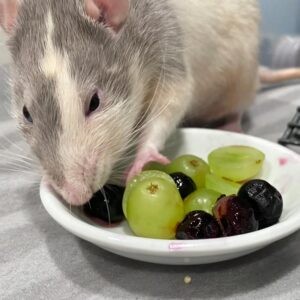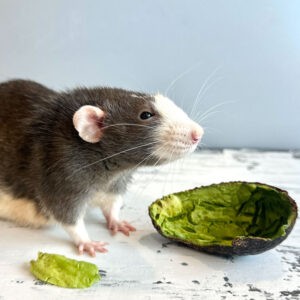Are you wondering, “Can Pet Rats Eat Honey?” At PETS.EDU.VN, we understand that providing your pet rats with a healthy and varied diet is essential. Honey can be a delightful treat for your furry friends, but it’s important to know how to offer it safely. Learn about the nutritional benefits and potential risks of feeding honey to pet rats, and discover expert tips to ensure a balanced diet for your little companions. This comprehensive guide will cover everything from appropriate serving sizes to recognizing signs of allergies, and it’s filled with practical advice on rat nutrition, dietary guidelines, and safe treats for rats.
1. Understanding Pet Rat Dietary Needs
Pet rats have specific dietary requirements that need to be met to ensure their health and well-being. A balanced diet for rats should consist primarily of high-quality rat food, supplemented with fresh fruits, vegetables, and occasional treats. Understanding these needs is crucial before introducing new foods like honey into their diet.
1.1. Nutritional Requirements of Pet Rats
Pet rats require a diet that is balanced in protein, carbohydrates, fats, vitamins, and minerals. Their diet should consist of approximately:
- 12-14% Protein: Essential for growth, repair, and overall health.
- 60-70% Carbohydrates: Provides energy for daily activities.
- 4-5% Fat: Important for hormone production and nutrient absorption.
- Vitamins and Minerals: Crucial for various bodily functions.
Commercial rat foods are designed to meet these nutritional requirements, but supplementing with fresh foods can add variety and additional nutrients.
1.2. Importance of a Balanced Diet for Rats
A balanced diet is vital for preventing nutritional deficiencies and health problems in rats. Deficiencies can lead to a weakened immune system, poor coat condition, and increased susceptibility to illnesses. Obesity is also a concern if rats are fed a diet high in fats and sugars. Therefore, understanding the appropriate portion sizes and frequency of treats like honey is crucial.
1.3. Foods That Should Form the Basis of a Rat’s Diet
The foundation of a rat’s diet should be a high-quality commercial rat food. These foods are formulated to provide the necessary nutrients in the correct proportions. Supplementing this with fresh vegetables, fruits, and occasional protein sources can ensure a well-rounded diet.
| Food Category | Examples | Benefits |
|---|---|---|
| Commercial Food | Lab blocks, pelleted rat food | Balanced nutrition, consistent nutrient intake |
| Vegetables | Broccoli, kale, carrots, spinach | Vitamins, minerals, fiber |
| Fruits | Apples, bananas, berries | Vitamins, antioxidants, natural sugars (in moderation) |
| Protein | Cooked eggs, cooked chicken, tofu | Essential amino acids |
| Treats | Small amounts of seeds, nuts, and occasional honey (in moderation) | Adds variety, provides additional nutrients |



By providing a combination of these foods, you can ensure that your pet rat receives all the necessary nutrients for a healthy and happy life. For more detailed guidance on crafting the perfect rat diet, explore the resources available at PETS.EDU.VN.
2. Can Rats Eat Honey? The Sweet Truth
Honey can be a sweet and tempting treat for your pet rats, but it’s important to understand the potential benefits and risks associated with feeding them honey.
2.1. Nutritional Benefits of Honey for Rats
Honey offers several nutritional benefits for rats when given in moderation. It contains:
- Natural Sugars: Provides a quick source of energy.
- Antioxidants: Helps protect cells from damage.
- Vitamins and Minerals: Contains trace amounts of vitamins like B vitamins and minerals such as calcium and iron.
- Antibacterial Properties: May help support the immune system.
However, these benefits should be balanced against the potential risks of high sugar intake.
2.2. Potential Risks and Downsides
While honey can offer some benefits, it also carries potential risks:
- High Sugar Content: Can lead to obesity, dental problems, and diabetes.
- Stickiness: Can cause choking hazards if not properly diluted.
- Allergic Reactions: Although rare, allergic reactions can occur.
It’s crucial to monitor your rat’s reaction to honey and provide it in very small quantities.
2.3. What Experts Say About Honey and Rat Health
Veterinarians and rat experts generally advise caution when feeding honey to rats. They emphasize that honey should be considered a treat and not a staple food. The primary concern is the high sugar content, which can negatively impact a rat’s health if consumed in large amounts.
“Honey can be a nice treat for rats, but it should be given sparingly due to its high sugar content. Always ensure it is diluted to prevent choking hazards,” advises Dr. Emily Carter, a veterinarian specializing in small animal care.
Additionally, experts recommend consulting with a veterinarian before introducing honey into your rat’s diet, especially if your rat has underlying health conditions like diabetes or obesity. PETS.EDU.VN provides access to expert advice and resources to help you make informed decisions about your pet’s diet.
3. How to Safely Feed Honey to Your Pet Rat
If you decide to include honey in your pet rat’s diet, it’s essential to do so safely. Here are some guidelines to follow.
3.1. Appropriate Serving Sizes
The key to safely feeding honey to your rat is moderation. A tiny amount of honey, no more than a pea-sized portion, is sufficient. Here are some guidelines:
- Frequency: Offer honey no more than once or twice a week.
- Quantity: A small dab, equivalent to 1/8 teaspoon, is adequate.
- Dilution: Dilute the honey with water to reduce stickiness and prevent choking.
3.2. Methods of Preparation
Proper preparation can mitigate the risks associated with feeding honey to rats. Here are some methods to consider:
- Dilute with Water: Mix a small amount of honey with water to make it easier to swallow.
- Mix with Other Foods: Add a tiny amount of honey to a larger portion of a healthy food like cooked oatmeal or mashed vegetables.
- Use as a Binding Agent: In homemade rat treats, use a small amount of honey as a binding agent rather than offering it directly.
3.3. Recognizing Signs of Allergies or Adverse Reactions
It’s crucial to monitor your rat for any signs of allergic reactions or adverse effects after introducing honey into their diet. Signs to watch out for include:
- Skin Irritation: Redness, itching, or swelling.
- Digestive Issues: Diarrhea, vomiting, or loss of appetite.
- Respiratory Problems: Wheezing, coughing, or difficulty breathing.
- Behavioral Changes: Lethargy or hyperactivity.
If you notice any of these signs, discontinue feeding honey immediately and consult with a veterinarian. PETS.EDU.VN offers resources and contact information for veterinary professionals who can assist you with your pet’s health concerns.
4. Honey Alternatives: Healthy and Safe Options for Your Rat
If you’re concerned about the risks associated with feeding honey to your pet rat, there are several healthy and safe alternatives to consider.
4.1. Fruits and Vegetables as Natural Sweet Treats
Fruits and vegetables can provide natural sweetness and essential nutrients without the high sugar content of honey. Some excellent options include:
- Berries: Strawberries, blueberries, and raspberries are low in sugar and high in antioxidants.
- Apples: Offer small slices of apple without the seeds.
- Bananas: A small piece of banana can be a sweet and potassium-rich treat.
- Sweet Potatoes: Cooked sweet potatoes are a good source of vitamins and fiber.
4.2. Other Safe Sweeteners in Moderation
If you still want to offer a sweetener, consider these alternatives in very small amounts:
- Plain Yogurt: Provides probiotics and a small amount of natural sweetness.
- Unsweetened Applesauce: A good source of fiber and vitamins.
- Small Amount of Fruit Juice: Diluted fruit juice can be an occasional treat.
4.3. Homemade Rat Treat Recipes Using Safe Ingredients
Creating homemade rat treats allows you to control the ingredients and ensure that your pet is getting a healthy snack. Here’s a simple recipe:
Oat and Berry Rat Treats
- Ingredients:
- 1 cup rolled oats
- ½ cup mashed banana
- ¼ cup blueberries
- 1 tablespoon water
- Instructions:
- Preheat oven to 350°F (175°C).
- Mix all ingredients in a bowl.
- Form small, bite-sized cookies.
- Place on a baking sheet and bake for 15-20 minutes.
- Let cool completely before serving.
This recipe provides a healthy and delicious treat that your rat will love. For more rat-friendly recipes and dietary advice, visit PETS.EDU.VN.
A rat enjoying a serving of grapes, a safe and healthy treat option.
5. Comprehensive Guide to Rat Nutrition
Understanding the intricacies of rat nutrition can be overwhelming, but with the right information, you can ensure your pet rat receives the best possible care.
5.1. Essential Vitamins and Minerals for Rats
Rats require a variety of vitamins and minerals to maintain optimal health. Key nutrients include:
- Vitamin A: Supports vision, immune function, and skin health.
- Vitamin D: Essential for calcium absorption and bone health.
- Vitamin E: Acts as an antioxidant, protecting cells from damage.
- B Vitamins: Important for energy metabolism and nerve function.
- Calcium: Crucial for strong bones and teeth.
- Phosphorus: Works with calcium to maintain bone health.
- Iron: Necessary for red blood cell production.
Commercial rat foods are typically fortified with these essential nutrients, but supplementing with fresh foods can provide additional benefits.
5.2. Creating a Weekly Meal Plan for Your Rat
A well-structured meal plan can help ensure your rat receives a balanced diet throughout the week. Here’s a sample meal plan:
| Day | Main Food | Supplements | Treats (in Moderation) |
|---|---|---|---|
| Monday | Commercial rat food | Mixed vegetables (broccoli, carrots, kale) | Small piece of apple |
| Tuesday | Commercial rat food | Cooked sweet potato, small amount of tofu | Few sunflower seeds |
| Wednesday | Commercial rat food | Mixed berries (strawberries, blueberries) | Diluted yogurt |
| Thursday | Commercial rat food | Cooked egg, spinach | Small piece of banana |
| Friday | Commercial rat food | Cooked brown rice, peas | Homemade oat treat |
| Saturday | Commercial rat food | Mixed vegetables (bell peppers, zucchini) | Few pumpkin seeds |
| Sunday | Commercial rat food | Small amount of plain yogurt, cooked chicken | Small piece of melon |
This meal plan provides a variety of nutrients and flavors to keep your rat healthy and happy.
5.3. Recognizing and Addressing Nutritional Deficiencies
Nutritional deficiencies can manifest in various symptoms. Recognizing these signs early can help you address the issue before it becomes a serious health problem. Common signs of deficiencies include:
- Poor Coat Condition: Dry, brittle, or thinning fur.
- Lethargy: Lack of energy and decreased activity.
- Weight Loss: Unexplained decrease in body weight.
- Skin Problems: Rashes, sores, or infections.
- Behavioral Changes: Irritability or depression.
If you suspect your rat has a nutritional deficiency, consult with a veterinarian. They can perform tests to identify the specific deficiency and recommend appropriate dietary changes or supplements. PETS.EDU.VN offers resources and articles on recognizing and addressing common health issues in pet rats.
6. Debunking Common Myths About Rat Diets
There are many misconceptions about what rats can and cannot eat. Let’s debunk some common myths to help you make informed decisions about your pet’s diet.
6.1. Myth: Rats Can Eat Anything
Truth: While rats are known for being opportunistic eaters, they cannot eat everything. Certain foods are toxic or harmful to rats and should be avoided. These include raw sweet potatoes, blue cheese, and avocado skin and pit. Always research before introducing new foods.
6.2. Myth: Chocolate is Toxic to Rats
Truth: This is a common misconception. Dark chocolate, in moderation, can actually be beneficial for rats due to its bronchodilator properties, which can help with respiratory issues. However, milk chocolate should be avoided due to its high sugar content.
6.3. Myth: Citrus Fruits are Harmful to Male Rats
Truth: This myth stems from concerns about D-limonene, a compound found in citrus peels, potentially causing kidney damage or cancer in male rats. However, studies showing these effects used extremely high doses of D-limonene. Small amounts of citrus fruit are generally safe, but it’s best to avoid the peel.
6.4. Myth: Rats Need a Seed-Based Diet
Truth: While seeds can be a part of a rat’s diet, they should not be the primary component. Seed-based diets are often high in fat and low in essential nutrients. A balanced diet based on commercial rat food supplemented with fresh fruits and vegetables is more appropriate.
6.5. Myth: Rats Can’t Digest Dairy
Truth: Rats can digest dairy products like yogurt and cheese in small amounts. Plain yogurt is a good source of probiotics, which can benefit gut health. However, dairy products should be given in moderation due to their fat content.
While avocado pulp is safe, avoid feeding your rat the skin or pit.
7. Expert Tips for a Healthy and Happy Rat
Ensuring your pet rat lives a long and happy life involves more than just providing a balanced diet. Here are some expert tips to consider.
7.1. Importance of Fresh Water
Rats need constant access to fresh, clean water. Provide water in both a water bottle and a heavy ceramic bowl to prevent tipping. Change the water daily and clean the bottle and bowl regularly to prevent bacterial growth.
7.2. Providing Enrichment and Exercise
Rats are intelligent and active animals that require mental and physical stimulation. Provide a variety of toys, such as:
- Chew Toys: Wooden blocks, cardboard tubes, and hard plastic toys.
- Climbing Structures: Ladders, ropes, and platforms.
- Hiding Places: Cardboard boxes, igloos, and hammocks.
- Exercise Wheels: Solid-surface wheels to prevent foot injuries.
Encourage exercise by allowing your rat to explore a safe, rat-proofed area outside of their cage daily.
7.3. Social Interaction and Companionship
Rats are social animals and thrive on companionship. It’s best to keep rats in pairs or small groups. Spend time interacting with your rats daily, providing gentle handling and attention.
7.4. Regular Veterinary Check-Ups
Regular veterinary check-ups are essential for maintaining your rat’s health. A veterinarian can detect and treat health problems early, provide vaccinations, and offer advice on diet and care.
7.5. Maintaining a Clean and Safe Environment
A clean and safe environment is crucial for preventing illness and promoting well-being. Clean the cage regularly, removing soiled bedding and wiping down surfaces. Use a safe and absorbent bedding material, such as paper-based bedding or fleece. Avoid cedar and pine shavings, as they can cause respiratory problems.
8. Addressing Specific Health Concerns with Diet
Certain health conditions can be managed or alleviated with dietary adjustments. Here’s how to address some common health concerns in rats through diet.
8.1. Managing Obesity Through Diet
Obesity is a common problem in pet rats, often caused by overfeeding and a lack of exercise. To manage obesity:
- Reduce Treat Intake: Limit treats to occasional small portions.
- Increase Fiber Intake: Add more vegetables to the diet.
- Choose Low-Fat Options: Opt for lean protein sources and avoid high-fat foods like nuts and seeds.
- Monitor Portion Sizes: Ensure you are not overfeeding your rat.
8.2. Dietary Considerations for Rats with Respiratory Issues
Respiratory problems are common in rats. Certain dietary changes can help alleviate symptoms:
- Dark Chocolate: In moderation, dark chocolate can act as a bronchodilator.
- Omega-3 Fatty Acids: Found in fish oil and flaxseed, these can help reduce inflammation.
- Avoid Dusty Foods: Choose dust-free commercial rat food and avoid dusty bedding.
8.3. Supporting Kidney Health Through Diet
Kidney problems can occur in older rats. To support kidney health:
- Limit Protein Intake: Reduce the amount of protein in the diet.
- Ensure Adequate Hydration: Provide plenty of fresh water.
- Avoid High-Phosphorus Foods: Limit foods like cheese and nuts.
8.4. Nutritional Support for Aging Rats
As rats age, their nutritional needs may change. Provide a diet that is easy to digest and rich in antioxidants:
- Soft Foods: Offer soft foods like cooked oatmeal or mashed vegetables.
- Antioxidant-Rich Foods: Include berries and other antioxidant-rich fruits and vegetables.
- Supplement with Vitamins: Consider adding a multivitamin supplement to the diet.
Providing a balanced diet is essential for your rat’s overall health and well-being.
9. Frequently Asked Questions (FAQs) About Feeding Honey to Rats
Here are some common questions and answers about feeding honey to pet rats:
- Is honey safe for all rats?
- Honey is generally safe in small amounts, but it should be avoided in rats with diabetes or obesity.
- How much honey can I give my rat?
- A pea-sized portion once or twice a week is sufficient.
- Can honey cause allergies in rats?
- While rare, allergies can occur. Monitor your rat for signs of allergic reactions after introducing honey.
- Is raw honey better than processed honey?
- Raw honey may retain more nutrients, but both should be given in moderation.
- Can honey help with a rat’s respiratory issues?
- Honey has antibacterial properties that might soothe a sore throat, but dark chocolate is more effective as a bronchodilator.
- What should I do if my rat eats too much honey?
- Monitor your rat for digestive issues or hyperactivity. Contact a veterinarian if you notice any severe symptoms.
- Can I use honey as a binding agent in homemade rat treats?
- Yes, but use it sparingly due to its high sugar content.
- What are some healthy alternatives to honey for rats?
- Fruits like berries and bananas, or small amounts of plain yogurt.
- Is it okay to give my rat honey every day?
- No, honey should be an occasional treat, not a daily part of their diet.
- How should I store honey for my rat?
- Store honey in a tightly sealed container at room temperature.
10. Resources and Further Reading on Pet Rat Care
To continue learning about pet rat care and nutrition, here are some valuable resources:
- Rat Guide: A comprehensive resource on rat health and care.
- ASPCA Animal Poison Control: Information on toxic substances for animals.
- Pet Poison Helpline: 24/7 animal poison control center.
- Veterinary Clinics: Consult with a veterinarian specializing in small animal care.
- Rat Breeders and Experts: Seek advice from experienced rat breeders and experts.
Remember, providing the best care for your pet rat involves ongoing learning and attention to their individual needs. For more in-depth articles, guides, and expert advice, visit PETS.EDU.VN. We are committed to helping you provide the best possible life for your furry companions. If you have any concerns about your rat’s diet or health, don’t hesitate to reach out to us or consult with a veterinarian.
By understanding your pet rat’s nutritional needs and taking a balanced approach to their diet, you can ensure they live a healthy, happy, and fulfilling life. And remember, a little honey can be a sweet treat, but moderation and informed choices are key.
For more information or assistance, contact us at 789 Paw Lane, Petville, CA 91234, United States. Whatsapp: +1 555-987-6543. Or visit our website: PETS.EDU.VN.
Looking for reliable information and services for your beloved pet? Visit PETS.EDU.VN today and discover a wealth of resources to help you provide the best possible care for your furry friend. Whether you need advice on nutrition, health, or behavior, PETS.EDU.VN is your go-to source for all things pet-related. Explore our articles, connect with experts, and find the services you need to keep your pet happy and healthy. Don’t wait – start your journey to better pet care with pets.edu.vn now.
